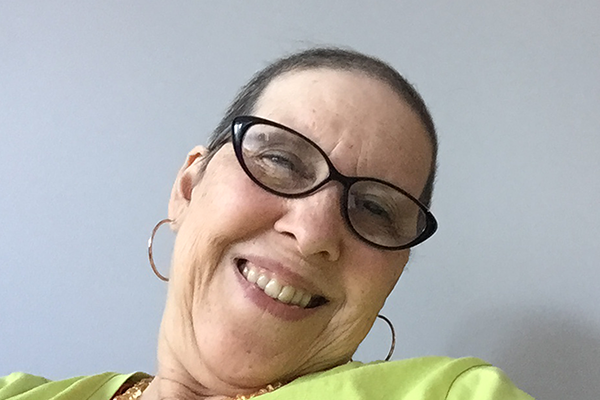Losing My Hair and Finding Myself
by Felicia Carparelli
Kermit the Frog used to sing, “It’s not easy bein’ green.” I’d like to amend that to say, “It’s not easy bein’ bald.” Losing my hair after chemotherapy for breast cancer was a real eye-opener.
As my oncologist predicted, after only one round of chemo, my hair started to fall out. This was about a week after my 66th birthday. My son and his girl- friend took me out for Honky Tonk BBQ; it was delicious. I wore a knit cap, as the Chicago air was starting to get chilly.
After that first chemo round, I was so scared. My body hurt in such unusual ways. I smelled different. I was frightened. One of my prescriptions rendered me weary and made my joints ache. I felt constricted any time I tried to take a deep breath. But I had hair, and I still looked like myself.
The day after my first infusion was a warm, sunny October day. I walked my two dogs around the block four times. I felt semi-human that first day. Four days later, now, that was a different story.
For the last 20 years, I have worn my hair in a short pixie style. Wavy in the back, straighter on top. I got a haircut every four to six weeks, a dye job to cover up the gray, and that was it.
When my hair started to fall out, it was gradual. But, oh, what a mess! I never thought short hair could require so much diligent cleanup. Hair in the bathtub, hair on the floor, in the sink, in my bed, it was everywhere.
Since I was waking up at 4 a.m. every day, because of the chemo, I had plenty of time to clean. I mopped it up, I picked it up, I threw it away. I ended up with strands on top, and fuzz on the back and sides. I looked like an aging blackjack dealer in a Godfather movie. It was weird.
When my hair started to fall out, it was gradual. But, oh, what a mess! Hair in the bathtub, hair on the floor, in the sink, in my bed, it was everywhere.
I bought wigs. One, a wild magenta piece that I got for 20 bucks on Amazon and which everyone loved. Another, a Raquel Welch number I found online. (Who doesn’t want to look like Raquel Welch?) I took them to my stylist; she cut them for me. I tried and tried but never felt comfortable in them. A bit hot, a bit scratchy, I felt conspicuous. I ended up donating them to an organization that helps people in need.
I ordered two dozen headscarves; chemo caps, they’re called. I picked out some adorned with rhinestones, hoping the glitter and glamour would distract my eyes and mind from knowing that, underneath, I had so little hair. I bought tie-dyed boho scarves, velour scarves with pearl embellishments, caps in solid colors that I could gild with glitter headbands if I was so inclined.
It’s cold in Chicago from November until April. During those days, I would put on a little beige wig cap before I slipped on the chemo scarf. The double layers helped me stay warm. Plus, I always wore hooded coats to keep the frigid Windy City air off my neck and ears. I was miserable being cold and bald and conspicuous. I felt as if everyone was looking at me and my layer of head coverings, and they knew I had cancer.
Now, when I look back, I think very few people even noticed. Occasionally, I would get a sympathetic look from a woman on the street or in the grocery store. I’m sure they must have been in my position before, or knew someone who had been.
Beauty is in the eye of the beholder, goes the old saying. I definitely embraced that attitude during my hair loss ordeal. I now have enough hair after eight months to sport a wiry, curly pixie ‘do. My hair, natural and undyed for the first time in 35 years, is salt and pepper. I kind of like it. It’s real, and it’s me.
Losing my hair forced me to assess the entire package. I want to gracefully accept my wrinkles, my uneven breasts, and my new hair. I think I’m doing a good job of liking the new me. I had some panicky moments when I wasn’t sure if my hair was ever going to come back; but it did – it is – slowly and surely.
Felicia Carparelli is a retired teacher, current dog walker, and accordion player living in Chicago, IL.
This article was published in Coping® with Cancer magazine, November/December 2020.
Everyone has a unique story to share. Do you want to share your survivor story? We consider a cancer survivor to be anyone living with a history of cancer – from diagnosis through the remainder of life. Here are our submission guidelines.


